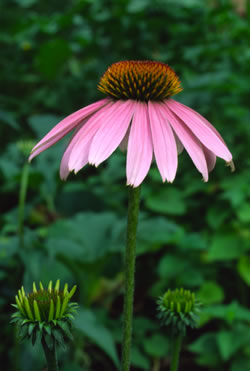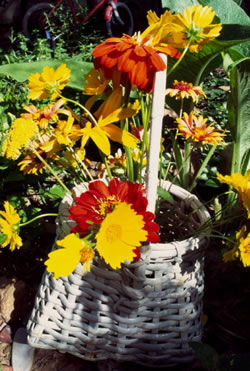Gardening
in winter is one of my favorite pastimes. I don’t mean
the digging and planting part of it, but the planning stage.
That would explain the plethora of mail-order seed and flower
catalogs that blossom in my mailbox like early daffodils.
January has been proclaimed ‘National Mail-order Gardening Month’ by
the Mail-order Gardening Association (MGA). This proclamation hints at
the popularity of ordering-by-phone garden products on winter days. According
to market research by the MGA, in 2005 more than 24 million American
households will spend an average of $128 on gardening supplies. That
totals a whopping $3.07 billion dollar industry. Whoever planted those
seeds is about to reap some bounty.
I will honestly admit to leafing through these catalogs, but it is more
to cultivate ideas than to place an order. Though I would rather be out
skiing in the La Sals or ice skating in the Sloughs (or maybe even working),
there are days when a second cup of java and a stack of these catalogs
occupy my time. I try to log it as “work time”, as I plan
the possibilities of enjoyment and employment through my home garden.
That may seem like an odd connection, but I use my flowerbeds and vegetable
patches as sources of photography and inspiration for articles. I have
sold numerous pictures of flowers, vegetables, insects, birds, toads,
and snakes that have graced my gardens. I’ve enjoyed flights of
butterflies, singing birds, croaking toads, and many a meal of salads
and vegetables. Since my yard is so small, a little planning can go a
long way.
So as I flip through the pages of these catalogs, I make some notes or
turn down the corner of a page as a bookmark. Most of the catalogs are
for either native Southwest species or plants that can withstand the
xeric conditions of this environment. Though we water our garden, we
do so sparingly. Adding amendments and compost to the soil helps in the
water-saving department, as well as does proper placement.
Shade tolerant species adapted to understory conditions or minimal light
exposure, do not go out into the full sun sections of the gardens. And
vice versa. I attempt to mimic natural growing conditions, using a system
of layering that incorporates trees, shrubs and forbs. Not only does
this maximize our small space, but also provides different habitat niches
that wild creatures occupy. For it is that wildlife that adds the final
dimension to the garden.
But back to the catalogs. As my list grows I include information about
watering and sun requirements, and whether or not the plant is butterfly
or hummingbird friendly. With butterflies in mind I try to select some
plants that are host species for caterpillars since these larval forms
often have different food preferences than the adults. I don’t
look at these herbivores as “pests” even though they’ll
be consuming my plants, but more as temporary guests that I’ve
decided to host. Even the tomato hornworms that might descend upon my
Romas or Beefstakes will transform from their “ugly duckling” phase
into a beautiful sphinx moth.
So armed with all this information, the selection process continues.
I check our stash of seeds – leftovers from last year and seed
that I collected last year and placed in cold storage. No sense buying
more coneflower seeds when I can use last year’s seed crop. Of
course, some seeds will not be viable or germination rates will be low.
As winter progresses into spring, I’ll know better about my seedling
success. Until then, I trust that some of the seeds will sprout.
Next up on my list is to check local sources. Though mail-order prices
may be lower than the local nurseries, I have had success in buying locally.
Not only do I like the concept of keeping my friends in business, but
if plants die or conditions are right for planting (like if I’m
leaving tomorrow) then working with local nurseries is easier for replacements
or available stock. Any business can post a nice image on their web site,
but sometimes the shipped plant does not appear quite as healthy as the
one in the photo.
Another factor is that I can purchase plants with floral buds or blooms
if I want or need some instant color. Sometimes I don’t get around
to planting in the fall, so this process fits my fickleness. Plus, what
better inspiration is there than walking through a garden nursery when
plants are in full bloom?
Finally, after all my local purchases are done, I see what is left on
my list. Most times this constitutes only vegetable seeds because no
one carried the varieties I like. Even though I lower the national average
on mail-order purchases of garden supplies, I have to be counted as one
of those 24 million people leafing through catalogs on cold, January
days. Besides, celebrating Snowplow Mailbox Hockey Day is just too hard
on the truck. |

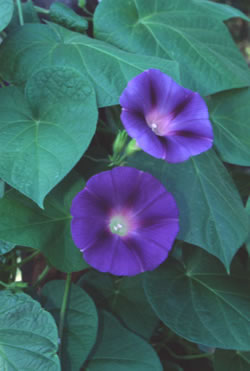

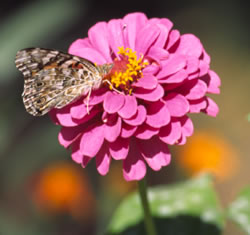
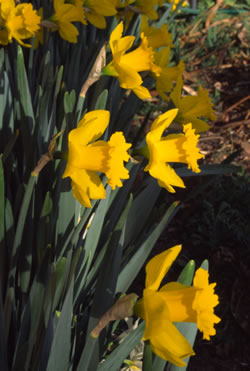
|






